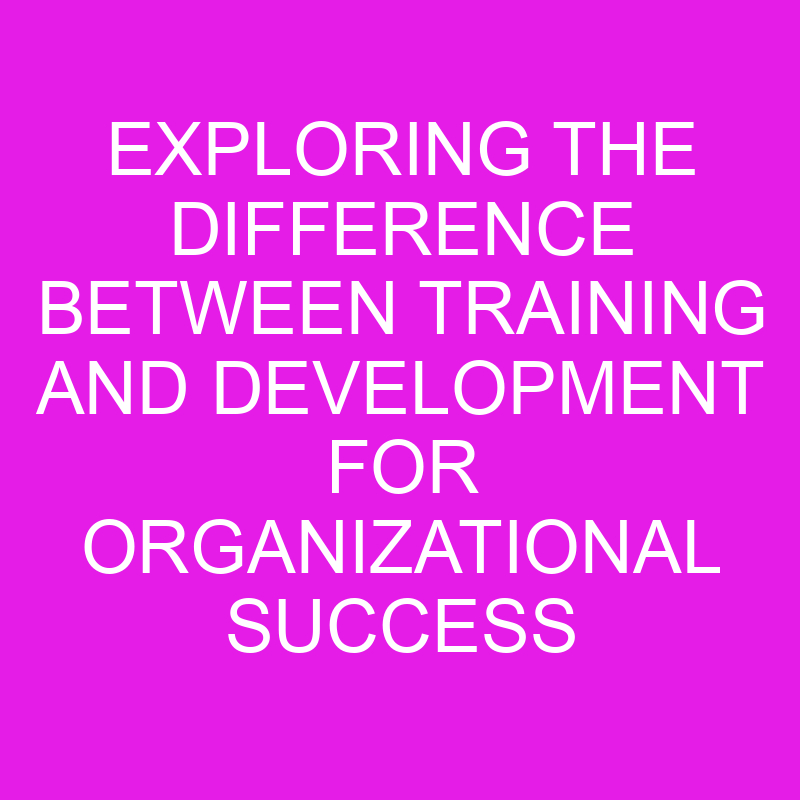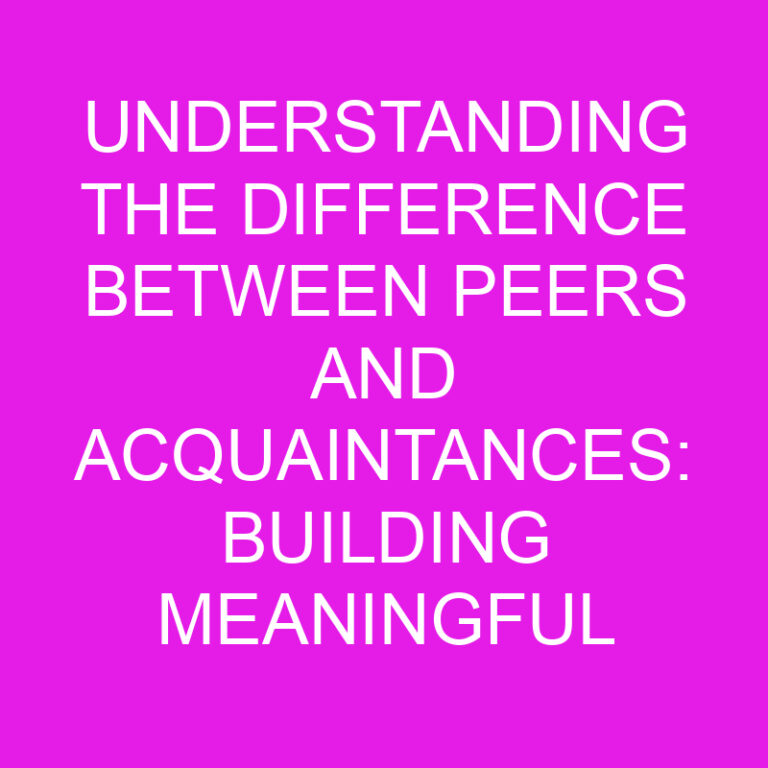
When it comes to enhancing skills and knowledge in the workplace, two terms often come up: training and development. While they may sound quite similar, there are distinct differences between the two. In this article, I’ll delve into the nuances of training and development, helping you understand their unique roles in professional growth.
Training is typically focused on providing specific skills and knowledge to employees to perform their current job effectively. It is a short-term process that aims to improve job-related competencies. Whether it’s learning how to use a new software or mastering a specific technique, training equips employees with the necessary tools to excel in their current roles.
On the other hand, development takes a broader and long-term perspective. It focuses on preparing employees for future roles and responsibilities within the organization. Development activities aim to enhance not only job-specific skills but also leadership abilities, critical thinking, and problem-solving capabilities. It involves a more holistic approach to personal and professional growth, with an emphasis on career advancement.
Post Contents
- Key Takeaways
- Understanding Training and Development
- Differences between Training and Development
- Importance of Training in the Workplace
- Benefits of Development for Career Growth
- Strategies for Effective Training and Development Programs
- Conclusion
- Frequently Asked Questions
- Q: Why is training and development important in the workplace?
- Q: What are the key strategies for implementing effective training and development programs?
- Q: How does training and development contribute to organizational success?
- Q: What are the benefits of ongoing support and feedback in training and development programs?
- Q: How can the effectiveness of training and development programs be measured and evaluated?
Key Takeaways
- Training is focused on providing specific skills and knowledge for current job performance, while development aims to prepare employees for future roles and responsibilities within the organization.
- Training is a short-term process that improves immediate job performance and enhances technical skills, while development is a long-term process that focuses on overall growth, career advancement, and the development of leadership abilities.
- Training programs have a shorter duration and target specific skill gaps, while development programs are ongoing and take a more strategic approach to cultivate competencies and capabilities.
- Both training and development are crucial for employee and organizational success, as they ensure that employees have the necessary skills, knowledge, and opportunities to excel in their current roles and advance their careers.
- Training helps enhance performance, increase productivity, improve job satisfaction, reduce errors and risks, and enable adaptability to change.
- Development empowers individuals, expands their skill set, enhances promotability, increases confidence, provides networking opportunities, and prepares individuals for future leadership roles.
- Effective training and development programs require clear objectives, assessment of training needs, utilization of diverse learning methods, ongoing support and feedback, and measurement and evaluation of effectiveness.
Understanding Training and Development
When it comes to enhancing employee skills and capabilities in the workplace, two terms that often come up in discussions are training and development. While both are crucial for improving employee performance, they differ in their focus and approach. Let’s take a closer look at each to understand their distinctions.
Training: Equipping Employees with Job-specific Skills
Training is a short-term process that aims to provide employees with the specific skills and knowledge needed to excel in their current roles. It focuses on improving job-related competencies and equipping employees with the necessary tools to perform their duties effectively.
During training, employees learn how to use certain software, follow specific procedures, or develop technical expertise in their field. The primary goal is to enhance their job-specific skills, ensuring that they can meet the requirements and demands of their current positions.
Key characteristics of training include:
- Short duration
- Specific and task-oriented
- Improves immediate job performance
- Enhances technical skills and knowledge
- Focuses on job-related competencies
Training sessions can take different forms, such as workshops, seminars, online courses, or on-the-job training. By providing targeted training, organizations can ensure that their employees are proficient in performing their responsibilities, leading to increased productivity and efficiency in the workplace.
Development: Preparing Employees for the Future
On the other hand, development takes a broader and long-term perspective. It focuses on preparing employees for future roles and responsibilities within the organization. Development not only enhances job-specific skills but also cultivates leadership abilities, critical thinking, and problem-solving capabilities.
Development is essential for grooming employees for career growth and progression within the company. It involves a more holistic approach to personal and professional growth, enabling individuals to take on higher-level positions and handle increased responsibilities.
Key characteristics of development include:
- Long-term process
- Focuses on overall growth
- Helps employees advance their careers
- Enhances leadership skills and abilities
- Develops critical thinking and problem-solving capabilities
Development opportunities can include mentoring programs, coaching sessions, job rotations, and leadership training. By investing in employee development, organizations can ensure a pipeline of capable leaders and foster a culture of continuous improvement.
Differences between Training and Development
When it comes to workplace learning and growth, training and development are two terms that are often used interchangeably. However, they have distinct differences in terms of purpose, scope, and duration. Let’s explore these differences in more detail:
- Purpose: Training focuses on providing specific skills and knowledge to employees for their current job. It aims to improve job-related competencies and equips employees with the necessary tools to excel in their roles. On the other hand, development takes a broader and long-term perspective. It prepares employees for future roles and responsibilities within the organization and aims to enhance not only job-specific skills but also leadership abilities, critical thinking, and problem-solving capabilities. Development involves a more holistic approach to personal and professional growth, with an emphasis on career advancement.
- Scope: Training is a short-term process that targets specific skill gaps or knowledge deficiencies. It is typically job-focused and aims to address immediate performance needs. On the other hand, development has a broader scope and focuses on cultivating overall competencies and capabilities that are beneficial beyond the current role. It takes a more strategic and forward-thinking approach to ensure employees are prepared for future challenges and opportunities.
- Duration: Training programs are usually shorter in duration, ranging from a few hours to a few weeks. They are designed to deliver targeted knowledge and skills efficiently. On the other hand, development is an ongoing process that takes place over an extended period. It includes various activities and interventions that span months or even years to foster growth and personal development.
While training and development serve different purposes, they are both essential for employee and organizational success. Organizations must invest in both to ensure that their employees are proficient in performing their responsibilities and have the necessary skills and capabilities to advance their careers within the company.
By providing training to address immediate skill gaps and implementing development programs that cultivate long-term growth, organizations can create a culture of continuous learning and development which benefits both employees and the company as a whole.
Importance of Training in the Workplace
Training plays a vital role in the success of any organization. It is essential for equipping employees with the necessary skills and knowledge to perform their current jobs effectively and efficiently. Here are a few reasons why training is important in the workplace:
- Enhanced Performance: Training helps employees improve their performance by mastering new techniques and staying updated with the latest industry trends. It ensures that employees have the competencies and knowledge required to execute their tasks proficiently.
- Increased Productivity: Well-trained employees are more productive. They can complete their tasks with greater efficiency and effectiveness, leading to higher output and better results. Investing in training can significantly improve the overall productivity of the workforce.
- Employee Satisfaction: When employees receive proper training, they feel valued and supported by the organization. This leads to increased job satisfaction and motivation to perform well. A satisfied workforce is more likely to stay with the company for the long term, reducing turnover costs.
- Reduced Errors and Risks: Training helps minimize the occurrence of errors and risks. By providing employees with the necessary knowledge and skills, organizations can ensure that tasks are performed accurately and in compliance with regulations. This not only protects the company from potential legal issues but also maintains the reputation and credibility of the business.
- Adaptability to Change: In today’s fast-paced business environment, organizations continuously face new challenges and changes. Training enables employees to adapt to these changes by acquiring new skills and knowledge. It fosters a culture of continuous learning, which helps the organization stay competitive and agile.
Training is a crucial component of organizational success. It empowers employees, improves performance, increases productivity, and reduces errors and risks. By investing in training programs, organizations can create a skilled and adaptable workforce that is ready to tackle new challenges and drive business growth.
Benefits of Development for Career Growth
When it comes to career growth, development is invaluable. While training focuses on enhancing specific job-related skills, development takes a broader approach, aiming to improve an individual’s overall capabilities and potential.
Here are some key benefits of development for career growth:
1. Increased Job Satisfaction: Development opportunities empower employees to take control of their career advancement, leading to greater job satisfaction. When individuals are given the chance to grow and develop professionally, they are more engaged and motivated in their roles.
2. Expanded Skill Set: Development programs provide individuals with the opportunity to acquire new skills that go beyond their current job requirements. This helps them become more versatile and adaptable, opening up doors to new career opportunities both within and outside the organization.
3. Enhanced Promotability: By investing in development, organizations demonstrate their commitment to nurturing talent and promoting from within. Employees who actively engage in development activities are more likely to be considered for promotions and leadership positions, as they have demonstrated their drive for self-improvement.
4. Increased Confidence: Development helps employees gain confidence in their abilities. By receiving ongoing feedback, guidance, and support, individuals become more self-assured in their skills and capabilities, allowing them to tackle challenges and take on new responsibilities with ease.
5. Networking Opportunities: Development programs often provide opportunities for individuals to connect with colleagues, mentors, and industry experts. Building a strong professional network enhances career growth by opening doors to new collaborations, knowledge sharing, and potential career advancements.
6. Career Advancement: Development activities, such as coaching, mentoring, and advanced training, prepare individuals for future leadership roles. By honing their leadership capabilities, individuals increase their chances of being promoted to higher-level positions.
Development is essential for career growth, enabling individuals to stay competitive in a rapidly evolving job market. Investing in development benefits both employees and organizations by fostering a skilled and engaged workforce that drives business success.
Remember to keep reading for more insights on the difference between training and development.
Strategies for Effective Training and Development Programs
When it comes to implementing training and development programs in the workplace, it is crucial to have effective strategies in place. These strategies can help ensure that employees receive the necessary training and development opportunities that will benefit both the individual and the organization as a whole. Here are some strategies that I find to be highly effective:
- Identify Clear Objectives: Before designing any training or development program, it is important to identify clear objectives. These objectives should align with the organization’s overall goals and address specific areas that need improvement or development. By having clear objectives, it becomes easier to design and measure the effectiveness of the program.
- Assess Training Needs: To ensure that training and development efforts are targeted and relevant, it is essential to assess the training needs of employees. This can be done through surveys, interviews, or performance evaluations. By identifying the specific areas where employees require training or development, organizations can tailor their programs accordingly.
- Utilize a Variety of Learning Methods: People learn in different ways, so it is important to incorporate a variety of learning methods in training and development programs. This can include classroom-based training, e-learning modules, hands-on workshops, mentoring, and job rotations. By offering diverse learning opportunities, organizations can cater to the different learning styles and preferences of their employees.
- Provide Ongoing Support and Feedback: Training and development shouldn’t end once the program is completed. It is essential to provide ongoing support and feedback to employees to reinforce their learning and development. This can be done through coaching, performance reviews, and mentorship programs. Regular feedback and support help employees stay motivated and continue their growth beyond the initial training sessions.
- Measure and Evaluate Effectiveness: To ensure that training and development programs are effective, it is crucial to measure and evaluate their impact. This can be done through pre-and post-training assessments, performance evaluations, and feedback from participants. By analyzing the data and feedback, organizations can make improvements to future training and development initiatives.
Implementing these strategies can help organizations create effective training and development programs that drive employee growth and contribute to overall organizational success. By investing in the development of their workforce, companies can foster a culture of continuous learning and growth, leading to a more engaged and productive workforce.
Conclusion
In today’s competitive business environment, training and development play a crucial role in driving organizational success. By implementing effective strategies such as setting clear objectives, assessing training needs, utilizing various learning methods, providing ongoing support and feedback, and measuring effectiveness, organizations can create impactful training and development programs.
Training and development programs not only enhance employee skills and knowledge but also contribute to their overall growth and satisfaction. These programs empower employees to adapt to changing work environments, acquire new skills, and improve their performance. Furthermore, they foster a culture of continuous learning and development within the organization, leading to increased employee engagement and retention.
By investing in training and development, organizations can stay ahead of the competition, attract top talent, and build a skilled workforce. It is through these programs that employees are equipped with the necessary tools and resources to excel in their roles and contribute to the overall success of the organization.
Training and development are essential components of organizational success. By implementing effective strategies and investing in employee growth, organizations can create a culture of continuous learning and development, leading to improved performance and increased competitiveness in the market.
Frequently Asked Questions
Q: Why is training and development important in the workplace?
A: Training and development are important in the workplace because they enhance employee skills and knowledge, improve job performance, boost morale and motivation, and increase productivity and efficiency. By investing in training and development, organizations can foster employee growth, retain top talent, and stay competitive in the market.
Q: What are the key strategies for implementing effective training and development programs?
A: Key strategies for implementing effective training and development programs include setting clear objectives, assessing training needs based on job requirements, utilizing a variety of learning methods such as workshops, online courses, and mentoring, providing ongoing support and feedback, and measuring and evaluating the effectiveness of the programs.
Q: How does training and development contribute to organizational success?
A: Training and development contribute to organizational success by enhancing employee skills, improving job performance, increasing productivity, and driving innovation and growth. Well-trained employees are more likely to deliver high-quality work, meet organizational goals, and adapt to changes in the business environment. In turn, this leads to improved customer satisfaction, increased market share, and a competitive edge in the industry.
Q: What are the benefits of ongoing support and feedback in training and development programs?
A: Ongoing support and feedback in training and development programs ensure continuous improvement and help employees apply new knowledge and skills effectively. It provides opportunities for clarification, reinforcement, and addressing any challenges or issues that arise during the learning process. Regular feedback helps identify strengths and areas for improvement, motivates employees, and increases their confidence and engagement in the training and development programs.
Q: How can the effectiveness of training and development programs be measured and evaluated?
A: The effectiveness of training and development programs can be measured and evaluated by using various methods such as pre-and post-training assessments, performance evaluations, surveys, and feedback from participants and supervisors. Key indicators to assess include improvements in job performance, knowledge retention, application of skills, employee satisfaction, and impact on organizational goals. Evaluating the effectiveness of programs allows organizations to identify gaps, make necessary improvements, and ensure that the training and development initiatives align with organizational objectives.






